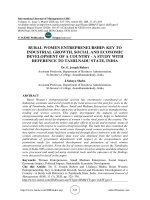Economic growth and economic development 57
Bạn đang xem bản rút gọn của tài liệu. Xem và tải ngay bản đầy đủ của tài liệu tại đây (135.27 KB, 1 trang )
Introduction to Modern Economic Growth
The other important assumption is that of constant returns to scale. Recall
that F exhibits constant returns to scale in K and L if it is linearly homogeneous
(homogeneous of degree 1) in these two variables. More specifically:
Definition 2.1. Let z ∈ RK for some K ≥ 1. The function g (x, y, z) is homo-
geneous of degree m in x ∈ R and y ∈ R if and only if
g (λx, λy, z) = λm g (x, y, z) for all λ ∈ R+ and z ∈ RK .
It can be easily verified that linear homogeneity implies that the production
function F is concave, though not strictly so (see Exercise 2.1).
Linearly homogeneous (constant returns to scale) production functions are particularly useful because of the following theorem:
Theorem 2.1. (Euler’s Theorem) Suppose that g : RK+2 → R is continuously
differentiable in x ∈ R and y ∈ R, with partial derivatives denoted by gx and gy and
is homogeneous of degree m in x and y. Then
mg (x, y, z) = gx (x, y, z) x + gy (x, y, z) y for all x ∈ R, y ∈ R and z ∈ RK .
Moreover, gx (x, y, z) and gy (x, y, z) are themselves homogeneous of degree m − 1 in
x and y.
Proof. We have that g is continuously differentiable and
(2.2)
λm g (x, y, z) = g (λx, λy, z) .
Differentiate both sides of equation (2.2) with respect to λ, which gives
mλm−1 g (x, y, z) = gx (λx, λy, z) x + gy (λx, λy, z) y
for any λ. Setting λ = 1 yields the first result. To obtain the second result,
differentiate both sides of equation (2.2) with respect to x:
λgx (λx, λy, z) = λm gx (x, y, z) .
Dividing both sides by λ establishes the desired result.
43
Ô









